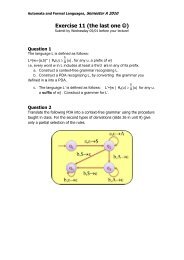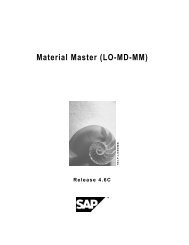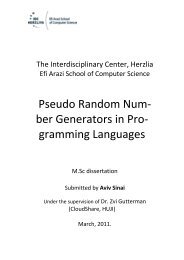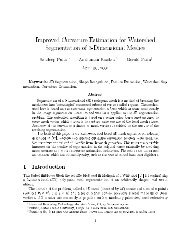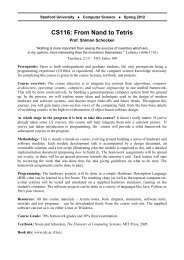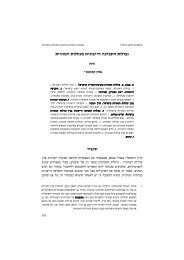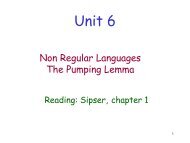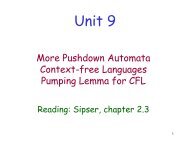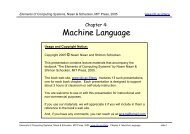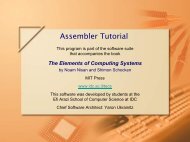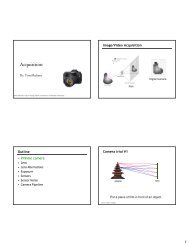Partitioning 3D Surface Meshes Using Watershed Segmentation
Partitioning 3D Surface Meshes Using Watershed Segmentation
Partitioning 3D Surface Meshes Using Watershed Segmentation
Create successful ePaper yourself
Turn your PDF publications into a flip-book with our unique Google optimized e-Paper software.
308 IEEE TRANSACTIONS ON VISUALIZATION AND COMPUTER GRAPHICS, VOL. 5, NO. 4, OCTOBER-DECEMBER 1999<br />
<strong>Partitioning</strong> <strong>3D</strong> <strong>Surface</strong> <strong>Meshes</strong> <strong>Using</strong><br />
<strong>Watershed</strong> <strong>Segmentation</strong><br />
Alan P. Mangan and Ross T. Whitaker<br />
AbstractÐThis paper describes a method for partitioning <strong>3D</strong> surface meshes into useful segments. The proposed method generalizes<br />
morphological watersheds, an image segmentation technique, to <strong>3D</strong> surfaces. This surface segmentation uses the total curvature of<br />
the surface as an indication of region boundaries. The surface is segmented into patches, where each patch has a relatively consistent<br />
curvature throughout, and is bounded by areas of higher, or drastically different, curvature. This algorithm has applications for a variety<br />
of important problems in visualization and geometrical modeling including <strong>3D</strong> feature extraction, mesh reduction, texture mapping <strong>3D</strong><br />
surfaces, and computer aided design.<br />
Index TermsÐ<strong>Surface</strong>s, surface segmentation, watershed algorithm, curvature-based methods.<br />
æ<br />
1 INTRODUCTION<br />
CONSIDER a <strong>3D</strong> surface mesh. It can be described as a set<br />
of faces that share edges, or a set of vertices that are<br />
connected to neighboring vertices by edges. In many cases,<br />
such meshes have no explicit higher-level structure; they<br />
exist simply as a collection of connected polygonsÐa bucket<br />
of polygons. One way to impose a higher level structure on<br />
such a mesh is to partition it into a set of connected pieces,<br />
which themselves have relationships to other pieces.<br />
Presumably, the pieces should represent something about<br />
the underlying structure of the object itselfÐthe semantic<br />
meaning of the object's parts and subparts. However, when<br />
no structure, other than the local connectedness of the<br />
polygons, is specified, any algorithm seeking to partition<br />
such meshes must infer some structure from the local shape<br />
(e.g., geometry) of the mesh itself. We call the problem of<br />
partitioning a <strong>3D</strong> surface mesh into meaningful, connected<br />
pieces the mesh segmentation problem. By meaningful, we<br />
propose that the relative size and organization of the<br />
segmented regions must be relevant to the application at<br />
hand. This problem bears a strong resemblance to the<br />
partitioning of images in image processing and computer<br />
vision. The mesh segmentation problem, like the image<br />
segmentation problem, is not well posed; solutions are often<br />
application specific, depending quite heavily on one's<br />
definition of ªmeaningful.º<br />
The <strong>3D</strong> mesh segmentation method we present here is<br />
based on the concept of ªcatchment basinsº or ªwatersheds,º<br />
which has been used previously in image segmentation<br />
[1]. For images, the algorithm operates on a height<br />
function (usually the gradient magnitude of the input<br />
image), which is defined over the image domain, typically<br />
some compact, continuous subset of < 2 . This work presents<br />
. A.P. Mangan is with Creare Inc., PO Box 71, Hanover, NH 03755.<br />
E-mail: spm@creare.com.<br />
. R.T. Whitaker is with the Department of Electrical Engineering,<br />
University of Tennessee, Knoxvill, TN 37996-2100.<br />
E-mail: rtw@utk.edu.<br />
For information on obtaining reprints of this article, please send e-mail to:<br />
tvcg@computer.org, and reference IEEECS Log Number 109330.<br />
a generaliztion of the watershed method in order to<br />
segment <strong>3D</strong> surface meshes. For the case of <strong>3D</strong> meshes,<br />
the height function is defined over the mesh itself. One such<br />
height function is the total curvature of the surface (or some<br />
approximation thereof) defined at each vertex of the mesh.<br />
There are several reasons why one would want to<br />
segment a <strong>3D</strong> mesh. Generally, datasets are more manageable<br />
at the higher level of abstraction that such a<br />
partitioning affords. There are also some specific applications<br />
that could benefit from such a capability. One example<br />
is mesh reduction [2], [3]. Effective mesh reduction algorithms<br />
can dramatically reduce the amount of data in a <strong>3D</strong><br />
mesh while maintaining, to a certain degree, the fidelity of<br />
the surface. Most mesh reduction algorithms operate on the<br />
data as a whole, with individual vertices or faces treated<br />
solely with respect to their immediate neighbors. However,<br />
we propose mesh segmentation as a preprocessing step that<br />
could indicate to subsequent mesh reduction algorithms<br />
that they should preserve distinct parts of objects. Results in<br />
this paper will show that a mesh segmentation technique<br />
that relies on surface curvature can help preserve edges,<br />
creases, and other fine details during subsequent mesh<br />
reduction.<br />
A related application is the reparameterization of<br />
irregularly connected meshes in order to apply successive<br />
reduction or refinement algorithms. For instance, Lee et al.<br />
[4] describe a technique that generates a hierarchy of<br />
regular meshes from irregularly connected meshes of<br />
arbitrary topology. This process can preserve designated<br />
vertices and edges that are important to the structure of the<br />
object. The generation of such special structures could<br />
require a great deal of user input. Alternatively, those<br />
structures could be generated automatically using a mesh<br />
segmentation algorithm such as the one described in this<br />
paper.<br />
Another application of mesh segmentation is the fitting<br />
of higher-order models to polygonal meshes. Because the<br />
proposed segmentation method breaks the surface into<br />
regions comprised of relatively consistent curvature (and<br />
bounded by high curvature), the geometry of the regions<br />
1077-2626/99/$10.00 ß 1999 IEEE
MANGAN AND WHITAKER: PARTITIONING <strong>3D</strong> SURFACE MESHES USING WATERSHED SEGMENTATION 309<br />
tends to be homogeneous. Rather than using mesh reduction<br />
to decrease the complexity of the surface data, largescale<br />
structures, such as planes, quadrics, superquadrics, or<br />
B-splines, can be used to model these areas. For example,<br />
indoor scenes, or those consisting primarily of artificial<br />
objects, tend to have more planar and angular surfaces than<br />
those occurring in nature. In such cases, a higher-level<br />
modeling scheme consisting of geometric primitives might<br />
be appropriate. Outdoor scenes, on the other hand, are<br />
typically less organized and might be better modeled using<br />
algebraic structures or B-splines. Each region of the surface,<br />
having been segmented and classified according to surface<br />
type, could have a model assigned to it.<br />
A further use of mesh partitioning is the modification of<br />
existing <strong>3D</strong> CAD models. As <strong>3D</strong> models become more<br />
ubiquitous and available from a large number of difference<br />
sources (e.g., through the internet), interesting models tend<br />
to be in formats that are inappropriate for certain applications.<br />
In such cases, people using these models will be<br />
interested in modifying them to suit their own needs. <strong>Using</strong><br />
the proposed surface segmentation scheme, a user could<br />
impose some structure on such models (perhaps after scan<br />
converting or tiling them). The model can then be modified<br />
on a region-by-region basis, making it easier to concentrate<br />
on a specific portion of the design. Sections and subassemblies<br />
of the model can be isolated for modification. Portions<br />
of structures in this manner could also be imported from<br />
existing parts databases and reused.<br />
Another application of mesh segmentation is feature<br />
detection. In some applications, such as medical imaging,<br />
one would like to locate points or lines on a surface that<br />
could serve as landmarks for comparing or aligning it with<br />
other surfaces. These landmarks should be relatively<br />
insensitive to noise and invariant to certain kinds of<br />
geometric transformations. One way to establish a set of<br />
landmarks is to use the boundaries of segments, particularly<br />
when those boundaries have some geometric interpretation,<br />
as is the case with the methods proposed in this<br />
paper.<br />
The remainder of the paper proceeds as follows: The next<br />
section describes some aspects of the literature that are<br />
related to the proposed algorithm. Section 3 presents the<br />
watershed algorithm in the context of images and then the<br />
generalization to <strong>3D</strong> meshes. After completion of the<br />
watershed segmentation, it is also necessary to perform an<br />
additional step of region merging in order to avoid oversegmentation,<br />
that is, to control the level of detail in the<br />
segmentation. That section also describes the region<br />
merging process and Section 4 explains how surface<br />
curvature is computed, both directly from isosurfaces of<br />
volumes and from vertex-list type geometric models.<br />
Section 5 presents results and analyzes the performance of<br />
the algorithm. It describes the capability of the algorithm to<br />
segment simple surfaces, the effects of added noise, and the<br />
performance of the algorithm when segmenting complex<br />
surfaces.<br />
2 RELATED WORK<br />
There are several somewhat diverse areas of research that<br />
are relevant to this work. One area is the problem in<br />
computational geometry of attempting to divide polyhedra<br />
into convex components. Another area is the<br />
detection of geometric features, namely creases, on<br />
continuous surfaces. Another related area is the problem<br />
of surface classification from range data. Last, there is<br />
that part of image processing which applies morphological<br />
watersheds to image segmentation.<br />
In the field of computational geometry, researchers [5],<br />
[6] have addressed the problem of dividing polyhedra into<br />
collections of convex pieces. Of course, the individual faces<br />
are each convex, but if one considers the optimal partitioning<br />
(e.g., smallest number of pieces), the problem is NPcomplete<br />
[7]. Several researchers have proposed reasonable<br />
algorithms for obtaining good solutions. Unlike the problem<br />
addressed in this paper, the convex-decomposition problem<br />
is purely geometric and is well posed; state-of-the-art<br />
research focuses on developing efficient algorithms. Such<br />
a convex decomposition is useful for algorithms that<br />
explicitly depend on convex objects (such as certain <strong>3D</strong><br />
rendering algorithms or collision detection), but less useful<br />
for applications that are trying to get a part-subpart<br />
decomposition that is related to the underlying structure<br />
of the object. For instance, a convex decomposition must<br />
partition hyperbolic regions into their constituent flat<br />
facesÐa partitioning which has little to do with the overall<br />
shape of an object (e.g., a torus) that happens to contain<br />
such regions. Fig. 1a shows an example of how two objects<br />
joined by a smooth fillet create a hyperbolic region. In this<br />
example, a convex decomposition will produce less than<br />
adequate results (Fig. 1b) and will, without heuristics,<br />
partition the hyperbolic region into its constituent (atomic)<br />
planar faces. In this same example, a curvature-based<br />
segmentation could, in principle, partition the surface along<br />
meaningful, intuitive boundaries (e.g., Fig. 1c) that divide<br />
the faces of objects and break the protrusion from the main<br />
body of the larger object.<br />
Another related problem is the detection of certain kinds<br />
of geometric features on surfaces. The detection of such<br />
features can be important in comparing, registering, and<br />
analyzing shapes. Perhaps the most closely related idea is<br />
ªridge detectionº on surfaces [8], [9]. Because ridges are<br />
usually assumed to be maxima in curvature, the operators<br />
required to detect them rely upon third- and fourth-order<br />
derivatives. Such derivatives are very sensitive to noise,<br />
requiring some robust approximation, such as a polynomial<br />
fit or a low-pass filterÐboth of which tend to distort the<br />
shapes of the features being detected. For this reason, there<br />
are few examples in the literature that make practical use of<br />
such surface ridges for segmenting <strong>3D</strong> meshes. Our method<br />
does not attempt to explicitly locate ridges. Rather, the<br />
surface is segmented into patches bounded by regions where<br />
sharp differences in surface normal create a boundary.<br />
Although these boundaries do occur at places of high<br />
curvature, the watershed algorithm makes no attempt to<br />
explicitly locate these edges/ridges and does not require<br />
derivatives beyond second-order (first-order derivatives of<br />
the normal).<br />
<strong>Surface</strong> segmentation is also related to the problem of<br />
surface classification. Extracting surface patches by identifying<br />
individual surface elements as certain types has played
310 IEEE TRANSACTIONS ON VISUALIZATION AND COMPUTER GRAPHICS, VOL. 5, NO. 4, OCTOBER-DECEMBER 1999<br />
Fig. 1. Convex decomposition. (a) A protusion is joined to a larger object by a smooth fillet, creating a hyperbolic region. (b) A convex decomposition<br />
divides the surface along lines that are not perceptually meaningful while decomposing the hyperbolic region into its constituent planar faces. (c) A<br />
curvature-based method could, in principle, partition the surface along lines that distinguish individual faces and part/subpart boundaries.<br />
an important role in high-order systems, such as <strong>3D</strong><br />
recognition. For instance, Fisher et al. [10] address the<br />
problem of extracting surface patches from range data with<br />
the goal of constructing CAD models. Their method uses a<br />
curvature-based surface classification algorithm to perform<br />
segmentation. Faugeras and Hebert [11] also approach the<br />
problem of <strong>3D</strong> segmentation from a scene recognition<br />
viewpoint. They perform geometric matching between<br />
primitive surfaces (mainly planar, although the more<br />
general case of quadrics is discussed). Besl [12] proposes<br />
using the mean and Gaussian curvatures in segmenting and<br />
classifying surfaces by type. These approaches are based on<br />
range data, which is always a graphÐa special class of <strong>3D</strong><br />
surfacesÐwhereas the method we propose is suited to the<br />
more general class of <strong>3D</strong> surfaces. We make use of the mean<br />
and Gaussian curvatures in calculating the total curvature,<br />
but do not explicitly attempt to classify any particular<br />
surface region. Rather than use only local differential<br />
structure to classify regions into one of several simple<br />
types, we partition regions based on the homogeneity of the<br />
surface normal, combining local information at many points<br />
to form a region. Thus, the proposed algorithm is broadly<br />
applicable to many types of <strong>3D</strong> surfaces and does not rely<br />
upon the classification and matching of any type of<br />
underlying geometric primitive.<br />
Similarly, the computer vision literature shows examples<br />
of the application of image segmentation techniques to<br />
surfaces, such as range maps, that are height functions, i.e.,<br />
z ˆ f…x; y†, defined on a rectilinear grid [13], [14]. These are<br />
essentially image segmentation techniques that include<br />
some analysis of the local image surface structure. The goal<br />
of this paper is to describe the generalization of one such<br />
algorithm to a full <strong>3D</strong> surface and demonstrate its<br />
effectiveness in addressing several problems in computer<br />
graphics and vision.<br />
The problem of segmentation is central to image<br />
processing and computer vision and has been an area of<br />
active research for more than 30 years. <strong>Watershed</strong>s for<br />
image segmentation are described in the classic work of<br />
Serra [1] on mathematical morphology. Since that time, they<br />
have found a wide range of applications including medical<br />
imaging [15], [16], shape analysis [17], and range-image<br />
segmentation [14]. KoeÈnderink and Van Doorn [18] argue<br />
for watersheds as a method of detecting ªridgesº as an<br />
alternative to constructing detectors that rely on higherorder<br />
derivatives. Eberly [9] gives a nice overview of that
MANGAN AND WHITAKER: PARTITIONING <strong>3D</strong> SURFACE MESHES USING WATERSHED SEGMENTATION 311<br />
Fig. 2. <strong>Watershed</strong> strategies. (a) The bottom-up approach to finding catchment basins is to start at a local minimum and incrementally flood the<br />
region until it connect to its neighbors. (b) The top-down approach is to place a token at a point and move the token along a steepest descent until it<br />
reaches a minimum.<br />
debate and also discusses the use of scalar functions defined<br />
on manifolds as a means of detecting ridges.<br />
In this paper, we use the notion of defining a scalar<br />
function on a manifold (in this case, the scalar function is<br />
surface curvature and the manifold is a <strong>3D</strong> surface mesh),<br />
but we apply morphological watersheds as a means of<br />
segmenting that surface. The algorithm we use traces points<br />
on the surface ªdownº to local minima, as in [15]. The<br />
difference with the proposed algorithm and previous work<br />
is the generalization of morphological watersheds to a <strong>3D</strong><br />
polygonal mesh and the use of a depth measure to reduce<br />
insignificant regions.<br />
3 WATERSHED ALGORITHM<br />
This section describes the strategy used in the watershed<br />
algorithm and the specifics of the implementation. The<br />
image processing version of the algorithm is first briefly<br />
introduced and an example of image segmentation using<br />
this approach is given. The generalization of the algorithm<br />
from a 2D rectilinear grid to an arbitrary surface with welldefined<br />
neighbor connectivity is then presented.<br />
3.1 <strong>Watershed</strong>s in Image Processing<br />
The watershed algorithm derives its name from the manner<br />
in which regions are segmented into catchment basins. Let<br />
f…x; y† : U !< be a continuous height function defined<br />
over the image domain U < 2 . A catchment basin is the set<br />
of points whose path of steepest descent terminates in the<br />
same local minimum of f. The choice of height function<br />
depends on the application; the basic algorithm is independent<br />
of the height function. For instance, one might choose<br />
the original image in order to locate blobs (light and dark<br />
regions), as in [15], or one could choose the gradient<br />
magnitude of the image in order to locate regions that are<br />
relatively homogeneous [14].<br />
After locating these minima in f, there are two strategies<br />
for associating catchment basins with these minima. One<br />
strategy is to incrementally ªfloodº the regions surrounding<br />
these minima, keeping track of the places where flood<br />
regions touch [1], [14]. This method typically requires one to<br />
discretize the range (or gray levels) of f, thus limiting the<br />
contrast resolution of the resulting segmentation. If the<br />
domain of f is discrete (as is usually the case), an alternative<br />
is to take each point in U and flow downward until one<br />
encounters a minimum or a point which has already been<br />
associated with a minimum (see Fig. 2). The connectivity of<br />
the points in U depends on the discretization, but, with<br />
rectilinear grids, four connectivity is usually sufficient. If<br />
labels are updated incrementally, the computation time is<br />
proportional to the number of points in the image times the<br />
connectivity. For <strong>3D</strong> mesh segmentation, we have chosen<br />
the latter approach, which we call the top-down approach,<br />
because it is better suited for the irregular topology of the<br />
<strong>3D</strong> mesh. In both algorithms, there are special cases that<br />
must be considered. For instance, there may be flat regions,<br />
plateaus, where there is no downhill direction across<br />
neighboring vertices. Such details are discussed in the<br />
sections that follow.<br />
An example of the application of the watershed algorithm<br />
to images serves as a good starting point for the<br />
extension to <strong>3D</strong> meshes. Fig. 13 shows an input image, the<br />
gradient magnitude of that image (which serves as f), and<br />
the segmentation that results from following pixels (using<br />
four-connected neighbors) through a steepest descent to the<br />
local minima.<br />
3.2 Extension to <strong>3D</strong><br />
Our goal is to extend this algorithm to a <strong>3D</strong> mesh consisting<br />
of connected vertices, each of which has a value of f and a<br />
set of connections to neighboring vertices, as displayed in<br />
Fig. 3. Let X be the set of all vertices in the mesh. For each<br />
x i X, there is a connected neighborhood of x i , N i X.<br />
Such a neighborhood is shown in Fig. 3. In the image<br />
processing case, we traverse a 2D network of points where<br />
each point's neighbors are defined by a rectilinear grid. In<br />
the case of a surface mesh, we move tokens around a<br />
network of points in <strong>3D</strong>, where each point's neighbors vary,<br />
depending upon the mesh geometry and connectivity at<br />
that point. A token moves from one vertex to its neighbor of
312 IEEE TRANSACTIONS ON VISUALIZATION AND COMPUTER GRAPHICS, VOL. 5, NO. 4, OCTOBER-DECEMBER 1999<br />
Fig. 3. Neighborhood relationships for a 2D rectilinear grid (left) and a <strong>3D</strong> mesh of connected vertices (right).<br />
lowest value until it reaches a minimum (which it must, by<br />
definition). The <strong>3D</strong> positions of the vertices are not relevant<br />
to this process; only the topology of the vertices and the<br />
values of the height function affect the formation of<br />
catchment basins. Thus, the shape of the surface affects<br />
the segmentation via the height function.<br />
Therefore, the steps of the watershed segmentation<br />
algorithm are as follows:<br />
1. Compute the curvature (or some other height<br />
function) at each vertex.<br />
2. Find the local minima and assign each a unique<br />
label.<br />
3. Find each flat area and classify it as a minimum or a<br />
plateau.<br />
4. Loop through plateaus and allow each one to<br />
descend until a labeled region is encountered.<br />
5. Allow all remaining unlabeled vertices to similarly<br />
descend and join to labeled regions.<br />
6. Merge regions whose watershed depth is below a<br />
preset threshold.<br />
The following sections describe in more detail the<br />
specific steps for computing the watershed segmentation.<br />
The input to the watershed method is a surface mesh and<br />
whatever additional information (e.g., surface normals) is<br />
necessary to calculate the curvature at each vertex. The<br />
algorithm then segments this mesh, using the curvature as<br />
the height function f. Thus, the first step of the segmentation<br />
is the calculation of curvature at each vertex on the<br />
surface. The method for calculating curvature should<br />
depend on the application and type of input data available.<br />
The methods for curvature calculation used in this work are<br />
discussed in Section 4. The watershed algorithm, per se, is<br />
independent of the type of curvature used.<br />
3.3 Initial Labeling<br />
Once the curvature (height function) is defined on the<br />
surface mesh, the watershed method labels all of the local<br />
minima, i.e., those vertices with curvature lower than that<br />
of all of their neighbors, as in Fig. 4a. Each minimum then<br />
serves as the initial basis for a surface segment, i.e., a<br />
distinct region on the surface formed during the descent of<br />
vertices along their paths of steepest descent. Next, flat<br />
regions are found. These are one of two types as shown in<br />
Fig. 4b; either flat plateaus or flat minima. Flat plateaus are<br />
defined as those flat regions that have any vertices adjacent<br />
to their borders with a lower curvature than that of the<br />
plateau itself. A variation of the algorithm is to define an<br />
additional type of flat region; the flat maximum, which has<br />
all adjacent points lower than itself. These maxima may also<br />
be used as indicators of borders between regions. We treat<br />
these maxima, if present, in the same manner as flat<br />
plateaus and do not explicitly define any points as border<br />
vertices. Flat minima have all adjacent vertices with higher<br />
curvatures than themselves. These minima are labeled and<br />
treated in the same manner as local single-vertex minima.<br />
Once all flat regions are found and classified, a descent is<br />
made from each of the flat plateaus until a labeled region is<br />
encountered. The curvatures of all adjacent vertices of the<br />
plateau are examined and the descent from the plateau<br />
begins at that vertex with the lowest curvature.<br />
3.4 Descent<br />
The process of associating points together into catchment<br />
basins is what gives this method the name ªwatershed.º<br />
Imagine a drop of water placed at the starting vertex,<br />
flowing downhill on the height function, i.e., toward the<br />
point of lowest curvature. The drop, or token, follows the<br />
path of gradient descent, and each vertex it encounters on<br />
its path ªdownwardº is labeled with the same identifying<br />
label as the first labeled vertex it encounters, as shown in<br />
Fig. 2b. This token moves all of the way to a local (labeled)<br />
minimum or hits a labeled vertex that has already been<br />
associated with a minimum. Initially, descent is made from<br />
flat plateaus, followed by the remaining unlabeled vertices<br />
on the surface. The plateau and its path of descent are then<br />
labeled and joined to the region finally hit during the<br />
descent. If another flat plateau is encountered, then the two<br />
are joined and the resulting plateau will later descend in<br />
turn until a minimum is encountered. The plateaus are<br />
indexed, and joined as necessary, so that a token, upon<br />
reaching a plateau, can move through it in one step and<br />
continue its descent. The next step is to allow all other<br />
unlabeled vertices to similarly descend until they hit a<br />
labeled region, then label them and join them to that region.<br />
3.5 Region Merging<br />
The final step of labeling each vertex according to its<br />
associated minimum produces a segmented mesh. However,<br />
the watershed, as it stands, is sensitive to even the
MANGAN AND WHITAKER: PARTITIONING <strong>3D</strong> SURFACE MESHES USING WATERSHED SEGMENTATION 313<br />
Fig. 4. Initial labeling. (a) Labeling of local minima and (b) classification of flat regions.<br />
smallest fluctuations in surface shapeÐevery local minimum<br />
of curvature establishes its own region. Leaving the<br />
surface in this state can yield a solution with regions that<br />
are too small and numerous to be useful (as shown in<br />
Fig. 10). It is necessary to merge the regions together in<br />
order to obtain reasonable results. The strategy is to use a<br />
saliency measure and the structure of the catchment basins<br />
to define a merging process.<br />
There are a variety of possibilities for metrics that<br />
indicate insignificant regions, but the watershed algorithm<br />
itself gives a fairly reliable metric for determining the<br />
saliency of a segment. This metric is the greatest depth of<br />
water that a segment can hold before it ªspills overº into<br />
one of its neighbors. Regions that are ªshallowº are<br />
relatively constant in curvature, i.e., their boundaries have<br />
a curvature which is not significantly greater than the<br />
flattest part of that region. The watershed depth can be<br />
calculated as the difference between the point in the region<br />
with the overall lowest curvature (the local minimum) and<br />
the vertex along the region's boundary with the lowest<br />
curvature of all other boundary vertices, as in Fig. 5. This is<br />
the depth of water that the region can hold before it begins<br />
to overflow its boundary.<br />
In calculating the lowest boundary point of a segment, it<br />
may be necessary to take into account those vertices<br />
immediately past the current region's boundary. This is a<br />
side effect of the discrete nature of the grid; because the<br />
watershed algorithm labels all vertices as being in one<br />
region or another, even though segments are separated by a<br />
single ridge of vertices which have downhill neighbors that<br />
flow into two separate catchment basins. These ridge<br />
vertices determine the minimum watershed depth. Notice<br />
that, in Fig. 5, the depth is found using such a vertex, vertex<br />
A. If the depth had merely been calculated using the vertex<br />
with the lowest curvature belonging to the current region,<br />
then vertex B would have been used, resulting in an<br />
incorrect, lower depth.<br />
The region merging algorithm is as follows:<br />
1. For each region, find its lowest point, neighbors, and<br />
lowest boundary point with each neighbor.<br />
2. Find depth of region, the difference between the<br />
lowest point to lowest boundary point.<br />
3. If depth is below a predefined threshold, merge this<br />
region to region adjacent to lowest boundary point<br />
and update new region's information accordingly.<br />
4. Repeat until no regions exist that are below the<br />
minimum depth.<br />
Once the depths of all regions are computed, those<br />
regions below the depth threshold are merged with their<br />
neighbors. In this manner, adjacent regions, at least one of<br />
which has a shallow depth, as in Fig. 6, are combined<br />
together. This drives the solution away from being oversegmented<br />
toward a more useful result. This merging<br />
process can be done very efficiently using the appropriate<br />
data structures and keeping a lookup table of merged<br />
regions. Several pieces of information must be tabulated for<br />
each region. The vertex with the lowest curvature for the<br />
region is found and used to later estimate the depth of the<br />
region. The boundary of the region is found and, from this,<br />
all neighboring regions are determined. For each neighbor<br />
B, the boundary vertex of the current region A adjacent to B<br />
with the lowest curvature is also found. From these<br />
boundary vertices, the lowest (in terms of curvature)<br />
boundary vertex of the region is then calculated. With this<br />
information, available region merging can then proceed.<br />
When a shallow region is identified, the neighboring<br />
region into which the lowest boundary vertex would flow<br />
during descent is selected as that one with which to merge.<br />
This resolves any ambiguity that might arise in the case of<br />
there being more than one neighboring region adjacent to<br />
the lowest boundary vertex. For implementation purposes,
314 IEEE TRANSACTIONS ON VISUALIZATION AND COMPUTER GRAPHICS, VOL. 5, NO. 4, OCTOBER-DECEMBER 1999<br />
Fig. 5. Defining the depth of a region based on its lowest vertex and lowest boundary vertex.<br />
rather than relabeling all of the region's vertices with the<br />
label of the neighboring region it just merged with, a<br />
pointer is set for the region indicating with which region it<br />
is merged. The pointers of all other regions merged with<br />
this one are also updated to reflect the new region with<br />
which they are now merged.<br />
When merging regions, one must also update the<br />
information of the new region regarding lowest vertex,<br />
lowest boundary vertex, and neighbors. Comparing and<br />
changing the lowest curvature vertex is straightforward;<br />
adjusting the neighbor information of this new region is<br />
somewhat more complicated. All of the current region's<br />
neighbors need to be added as neighbors of the new region<br />
unless they themselves have been merged with the new<br />
region previously. The current region, and all other regions<br />
in turn merged with it, are then removed from the new<br />
region's list of neighbors. The boundary vertices associated<br />
with these neighbors also are removed from their respective<br />
lists. The new lowest boundary vertex is next recalculated,<br />
necessary in case the region associated with the previous<br />
lowest boundary vertex. The regions are merged in this<br />
manner according to Fig. 7. Once this information is<br />
updated, the new lowest boundary vertex has to be<br />
calculated and set. This merging procedure is repeated,<br />
cycling through all of the regions consecutively until no<br />
Fig. 6. Merging adjacent regions with shallow depths.<br />
further regions are within the preset depth threshold. At<br />
this point, the watershed algorithm is complete.<br />
This basic strategy can be extended to incorporate other<br />
measures of saliency. Another natural measure is to<br />
compute the volume of the watershed (i.e., average depth<br />
times area), which would favor larger regions over smaller<br />
ones. One could also bring other information into this<br />
metric, such as triangle coloring or texture coordinates. We<br />
have experimented with area-based metrics and found that<br />
they penalize small areas too aggressively, which produces<br />
inferior results for the examples we have considered. The<br />
development, implementation, and verification of other<br />
saliency measures is an area for future work.<br />
4 CURVATURE CALCULATION<br />
The calculation of curvature depends on the type of data<br />
used and the level of noise in that data. In this work, we<br />
consider two different types of input: volumes whose<br />
voxels represent the value of some implicit function and<br />
simple surface meshes consisting of only vertices and<br />
triangles. In the former case, we can use the volume data<br />
itself to directly compute accurate estimates of the<br />
curvature of the embedded surface. Given a polygonal<br />
mesh (without an embedding) as input, there are several<br />
possibilities for discrete approximations to surface curvature.<br />
One approximation is the angle between the faces that<br />
are adjacent to a vertex. Another option is the norm of the<br />
covariance of the surface normals or edges that are adjacent<br />
to that vertex.<br />
4.1 Isosurface Curvature<br />
In the case of volumes, we are segmenting meshes<br />
corresponding to isosurfaces. The meshes are generated<br />
using the marching cubes algorithm [19]. Therefore, we<br />
can compute the curvature of the isosurface using the<br />
values of the volume itself as the surface is extracted.<br />
This provides a slightly more accurate estimate of the<br />
surface curvature than that obtained using the faces that
MANGAN AND WHITAKER: PARTITIONING <strong>3D</strong> SURFACE MESHES USING WATERSHED SEGMENTATION 315<br />
Fig. 8. Thresholding the total curvature.<br />
Fig. 7. Region merging. As each new region is added to the current<br />
region, indicated by the shaded area, its list of neighbors and associated<br />
boundary vertices needs to be updated accordingly.<br />
are generated from the marching cubes algorithm. For the<br />
magnitude of the curvature, we use the deviation from<br />
flatness [20], which is defined to be the Euclidean norm of<br />
the shape tensor. The mean, H, and Gaussian<br />
curvature,K, are first found from [21],<br />
<br />
2 x … yy ‡ zz †‡ 2 y … <br />
xx ‡ zz †<br />
‡ 2 z<br />
H ˆ<br />
… xx ‡ yy †2 x y xy 2 z x xz 2 y z yz<br />
… 2 x ‡ 2 y ‡ 2 z †3=2<br />
K ˆ<br />
0<br />
2 x … yy zz yz yz †‡ 2 y … 1<br />
xx zz xz xz †<br />
@ ‡ 2 z … xx yy xy xy †‡2… x y … xz yz xy zz † A<br />
‡ y z … xy xz yz xx †‡ z x … xy yz xz yy ††<br />
… 2 x ‡ 2 y ‡ ;<br />
2 z †2<br />
where represents the value of the implicit function at a<br />
given point in the volume. The total curvature, D, is then<br />
calculated using:<br />
p<br />
D ˆ<br />
<br />
4H 2 2K 2 : …3†<br />
When computing the curvature values, we sometimes<br />
apply a threshold to the curvature, as shown in Fig. 8. This<br />
step is performed so that relatively flat areas where the<br />
curvature is extremely low throughout will be classified as<br />
exactly flat, easing the computational burden during later<br />
processing. This threshold does not have a significant affect<br />
on the final result because such shallow watersheds would<br />
be merged in the last part of our algorithm, as discussed in<br />
Section 3.5. Once this threshold has been applied, the<br />
watershed algorithm proper can begin.<br />
4.2 <strong>Surface</strong> Mesh Curvature<br />
There are several possibilities for finding the curvature of<br />
surfaces represented by polygonal meshes. We have<br />
…1†<br />
…2†<br />
experimented with two different approaches and achieved<br />
varying degrees of success for each. The first method uses<br />
the angles between the faces of the triangles to determine<br />
the curvature. The second uses the norm of the covariance<br />
of the surface normals adjacent to the vertex in question.<br />
The latter method proved to be the most successful because<br />
it is less sensitive to noise and it averages across faces that<br />
are composed simply of pairs of coplanar triangles.<br />
To find the covariance matrix, the variance and covariance<br />
in all three cardinal directions must first be found. The<br />
variance and covariance are found from:<br />
2 aa ˆ 1 X N<br />
…a t a† 2<br />
…4†<br />
N<br />
tˆ0<br />
2 ab ˆ 1 X N<br />
…a t a†…b t b†<br />
N<br />
tˆ0<br />
…5†<br />
a 2fx; y; zg b 2fx; y; zg: …6†<br />
N represents the number of triangles associated with this<br />
vertex and ‰x t y t z t Š are the components of the normal for<br />
triangle t. Also, ab ˆ ba . The curvature, D, is then set equal<br />
to the norm of the covariance matrix, C;<br />
2<br />
xx xy<br />
3<br />
xz<br />
D ˆkCk C ˆ 4 yx yy yz<br />
5: …7†<br />
zx zy zz<br />
4.3 Edge-Node <strong>Meshes</strong><br />
If the input to the algorithm is a triangle (or polygonal)<br />
mesh rather than a volume, one must also consider the<br />
segmentation relative to the underlying structure of the<br />
mesh. So far we have assumed that we are dealing with a<br />
mesh created from a volume and that the mesh is ªdense,º<br />
i.e., there are many vertices for each surface region. The<br />
watershed algorithm operates on connected nodes in this<br />
mesh. However, for tessellated surfaces, the model is<br />
frequently sparse, with just enough vertices to define each<br />
surface (particularly a problem in planar areas), and some<br />
large regions might not contain enough vertices to define a<br />
catchment basin with an associated boundary.<br />
This problem can be solved by creating a new mesh, the<br />
dual of the original, which has a node for each edge in the<br />
original mesh and a connection to each adjacent edge (now<br />
nodes) across the faces of the two neighboring triangles (or<br />
polygons). This shifts the emphasis of the algorithm from<br />
the vertices to the polygons of the mesh. For each edge, i.e.,<br />
between every pair of vertices, in the original mesh, there is<br />
a corresponding node in the new mesh. The curvature of<br />
this node is then set as the average of its neighboring<br />
vertices' curvatures. After region merging is performed,
316 IEEE TRANSACTIONS ON VISUALIZATION AND COMPUTER GRAPHICS, VOL. 5, NO. 4, OCTOBER-DECEMBER 1999<br />
curvature) at each node, a variety of different approximations<br />
and preprocessing algorithms can be applied to both<br />
the mesh itself and the height function. For instance, an<br />
iterative smoothing process could be applied to the height<br />
function in order to reduce the effects of noise and<br />
approximation errors. Such preprocessing is an area of<br />
ongoing investigation and is beyond the scope of this paper.<br />
Fig. 9. Creation of edge-based topology based on original mesh.<br />
triangle regions are established, with each triangle being<br />
evaluated for region membership based on whether all<br />
three of its edges belong to the region in question.<br />
Because the watershed algorithm is independent of how<br />
one structures the mesh or computes the height function (or<br />
5 RESULTS<br />
In this section, we present the results of using the watershed<br />
algorithm to perform segmentation of surface meshes. We<br />
show initial results obtained prior to region merging;<br />
examination of these oversegmented solutions demonstrates<br />
the need for region merging. The algorithm's<br />
capability to successfully segment simple geometric shapes<br />
is demonstrated. The performance of the algorithm in the<br />
presence of noise is analyzed. The sensitivity of the<br />
segmentation to the user-defined threshold is shown.<br />
<strong>Segmentation</strong> results for the edge-node meshes, described<br />
in Section 4.3, are then given. Finally, some examples of<br />
applications that benefit from the use of this segmentation<br />
technique are given, such as mesh reduction and region<br />
extraction for CAD models.<br />
Fig. 10. Oversegmentation resulting from not applying the final region merging step of the algorithm.
MANGAN AND WHITAKER: PARTITIONING <strong>3D</strong> SURFACE MESHES USING WATERSHED SEGMENTATION 317<br />
Fig. 11. <strong>Segmentation</strong> of various test surface types. (a) Cube (six regions), (b) cylinder (three regions), (c) sphere (one region), and (d) torus (two<br />
regions).<br />
5.1 Oversegmentation<br />
This section demonstrates the need for region merging by<br />
displaying some results obtained without performing the<br />
final merging step. As is seen in Fig. 10, the output of the<br />
watershed algorithm suffers quite badly from oversegmentation.<br />
Any small defects or noise present in the initial<br />
model allow the formation of bumps on the surface. If these<br />
bumps are concave, they in turn lead to the creation of local<br />
minima, which become isolated regions as neighboring<br />
vertices flow into them.<br />
5.2 <strong>Segmentation</strong> of Simple <strong>Surface</strong>s<br />
Fig. 11 shows the segmentation results for several analytically<br />
defined surfaces with known curvature characteristics.<br />
Fig. 11a shows the segmentation of a cube (extracted from a<br />
volume), the six faces of which are planar, each separated<br />
by a ªwallº of high curvature. The high curvature at the<br />
edges of the cube allows the algorithm to decompose the<br />
surface into the six regions as shown. A similar boundary of<br />
high curvature separates the two planar areas at the ends of<br />
the cylinder in Fig. 11b. The sphere also has a consistent<br />
degree of curvature throughout its surface and is segmented<br />
into a single region in Fig. 11c. The torus in Fig. 11d has<br />
varying curvature and surface type (it is hyperbolic on the<br />
inner hull and elliptic on its outer hull). The curvature also<br />
has a pair of maximal loci around the inner and outer hulls<br />
that have created the boundary between the two regions as<br />
displayed.<br />
5.3 Noise Analysis<br />
This section examines the performance of the algorithm in<br />
the presence of additive, uniform noise. For the following<br />
analyses, uniform noise is added to the curvature of the<br />
vertices as a percentage of the range of curvature for the<br />
object, D vertex ˆ D vertex …X% of…D max D min ††. Fig. 12<br />
shows how noise affects the segmentations of a torus and<br />
a cube. The torus has a relatively constant level of curvature<br />
on its surface, whereas the cube has, in effect, zero<br />
curvature except at the boundaries between faces. Fig. 12a,<br />
Fig. 12b, and Fig. 12c show the torus with varying levels of<br />
additive noise applied to the curvature of each vertex. For<br />
small levels of noise, 2.5 percent to 5 percent, the boundary<br />
between regions moves, but the torus is still segmented into<br />
two regions, as appropriate. However, as the noise reaches<br />
10 percent, the partitioning fails dramatically and the torus<br />
is oversegmented into 36 regions. At this noise level, the<br />
segmentation no longer corresponds to the underlying<br />
geometry of the torus. The cube, Fig. 12d, Fig. 12e, and Fig.<br />
12f, displays less sensitivity to small levels of noise. Adding<br />
small levels of noise to the boundaries separating the planar<br />
faces has negligible effect. As with the torus, once the noise<br />
reaches a sufficiently high level, 10 percent, the boundary<br />
curvature is no longer significantly higher than the faces<br />
and the segmentation breaks down.<br />
5.4 Threshold Sensitivity<br />
The algorithm displays sensitivity to the user-specified<br />
threshold encountered in the region merging step. Varying<br />
the threshold allows for different levels of segmentation, the
318 IEEE TRANSACTIONS ON VISUALIZATION AND COMPUTER GRAPHICS, VOL. 5, NO. 4, OCTOBER-DECEMBER 1999<br />
of view [22]. Because this data is from a sensor, it shows<br />
some level of noise. A comparison of results of segmentations<br />
using different threshold levels shows that increasing<br />
the threshold leads to fewer final regions, as those with<br />
successively lower depths are merged with neighboring<br />
regions. The boundaries between regions in Fig. 14a<br />
represent edges and breaks that are not as highly curved<br />
as those in Fig. 14d. There are several areas of interest in the<br />
scene that are initially segmented into several pieces, but, as<br />
the threshold increases, they are gradually segmented into<br />
fewer, more coherent regions. Note how the floor is at first<br />
partitioned into multiple areas. The wall partitions, barrels,<br />
chairs, and printers (on the lefthand side of the scene) are<br />
also partitioned into successively fewer regions.<br />
Fig. 15 shows the segmentation of a dart object, again<br />
with several threshold levels. The surface in this case is<br />
much simpler than that shown in Fig. 14, yet also displays<br />
the same characteristics as the threshold varies.<br />
5.5 <strong>Segmentation</strong> Based on Mesh Input<br />
All of the segmentation examples thus far have been created<br />
using curvature calculated from volumetric inputs as<br />
discussed in Section 4.1. Here, we present a segmentation<br />
based on surface-based curvature, as described in Section<br />
4.2. The input to the system in this case is a surface mesh<br />
rather than a volume. Fig. 16 shows two segmentations of<br />
the mug model using different thresholds. This method is<br />
capable of generating useful results, but appears to be more<br />
prone to high frequency artifacts than segmentations<br />
produced from volumetric input. It is possible that these<br />
effects could be overcome by applying some type of lowpass<br />
filter to the curvature data; we have chosen here to<br />
concentrate on the segmentation aspects of the problem and<br />
leave this extension of the work for future completion.<br />
Fig. 12. Torus and cube segmentations with different levels of additive<br />
noise applied. (a) Torus, 2.5 percent noise (two regions), (b) torus, 5<br />
percent noise (two regions), (c) torus, 10 percent noise (36 regions), (d)<br />
cube, 2.5 percent noise (six regions), (e) cube, 5 percent noise (six<br />
regions), (f) cube, 10 percent noise (43 regions).<br />
exact level depending upon the final application. Fig. 14<br />
shows segmentation results for a <strong>3D</strong> model of a room that<br />
was built by fusing laser range images from different points<br />
5.6 Applications<br />
As mentioned previously, there are several areas that can<br />
benefit from this segmentation technique. The advantages<br />
of using surface segmentation in two of these areas, mesh<br />
reduction and CAD, are highlighted here.<br />
One of the possible applications of the proposed surface<br />
segmentation method is improving the results of mesh<br />
reduction algorithms. In Fig. 18, we show the results of<br />
applying mesh reduction to the dart for various reduction<br />
rates. We use an iterative edge-collapse decimation strategy<br />
[2], which incorporates a greedy algorithm operating on a<br />
Fig. 13. Example of image segmentation using the watershed algorithm. (a) Input image, (b) gradient magnitude of the input image, smoothed with a<br />
Gaussian filter, (c) segmentation of (b) using the watershed algorithm.
MANGAN AND WHITAKER: PARTITIONING <strong>3D</strong> SURFACE MESHES USING WATERSHED SEGMENTATION 319<br />
Fig. 14. <strong>Segmentation</strong> of a scene using varying thresholds, indicated by T. (a) T ˆ 0:275 (957 regions), (b) T ˆ 0:4 (498 regions), (c) T ˆ 0:425 (441<br />
regions), (d) T ˆ 0:455 (381 regions).<br />
Fig. 15. Dart segmentations. (a) T ˆ 0:15 (103 regions), (b) T ˆ 0:2 (64 regions), (c) T ˆ 0:4 (36 regions).<br />
Fig. 16. <strong>Segmentation</strong> of the mug model using surface-based curvature calculations. (a) T ˆ 0:05 (42 regions), (b) T ˆ 0:0025 (126 regions).<br />
curvature metric [23], [24]. Fig. 18a and Fig. 18b show the<br />
results of reduction by factors of 50 and 100 respectively.<br />
Fig. 18c and Fig. 18d display the improvement possible by<br />
specifying the same reduction rates on this surface after it<br />
has been segmented. In the latter case, reduction was not<br />
allowed across region boundaries, preventing edges between<br />
vertices in different regions from collapsing into a
320 IEEE TRANSACTIONS ON VISUALIZATION AND COMPUTER GRAPHICS, VOL. 5, NO. 4, OCTOBER-DECEMBER 1999<br />
Fig. 17. Several subassemblies of the dart model isolated via region extraction.<br />
single vertex. In this manner, the region boundaries (edges)<br />
are preserved.<br />
Another area that can benefit from the use of the<br />
segmentation method proposed here is that of computeraided<br />
design. It is possible to read in a general mesh model<br />
without any knowledge of its structure save its basic<br />
connectivity and segment it and extract any desired regions<br />
using the user-specified threshold. Subparts can then be<br />
analyzed in detail and the model modified by modifying or<br />
deleting assemblies as required. These parts and assemblies<br />
can then be added to a database of such parts and<br />
recombined and reused in different configurations as<br />
needed. A surface mesh can be created using an interactive<br />
<strong>3D</strong> model generation tool and measurements and specifications<br />
for various subassemblies then generated from the<br />
segmented model. Fig. 17 shows several parts of the dart<br />
extracted from the model as a whole.<br />
6 CONCLUSIONS<br />
We have presented here a method of surface segmentation<br />
which uses a generalization of watershed regions to <strong>3D</strong><br />
meshes. The method can segment either isosurfaces of a <strong>3D</strong><br />
volume or surface meshes directly into regions that are<br />
bounded by higher curvature. The algorithm displays some<br />
sensitivity to the user-specified threshold. Varying the<br />
threshold allows for different levels of segmentation, the<br />
exact level depending upon the final application.<br />
One aspect of the system that would benefit from future<br />
work is the method of calculating curvature for surface<br />
meshes. Currently, the results obtained from segmentation<br />
of these meshes are prone to high frequency aliasing and<br />
Fig. 18. Mesh reduction on unsegmented and segmented surface. (a) Reduction by a factor of 100 on the unsegmented dart, (b) the vertex<br />
connectivity of the unsegmented reduction, (c) reduction by a factor of 100 on the segmented dart, (d) the vertex connectivity of the segmented<br />
reduction.
MANGAN AND WHITAKER: PARTITIONING <strong>3D</strong> SURFACE MESHES USING WATERSHED SEGMENTATION 321<br />
the success of the segmentation depends heavily upon the<br />
coarseness of the grid sampling. Smoothing the curvature<br />
calculated from these surfaces will, in all probability,<br />
improve the segmentation results significantly.<br />
ACKNOWLEDGMENTS<br />
Thanks go to David Breen and the Computer Graphics<br />
Group at the California Institute of Technology for providing<br />
the dart volume data and to Chris Gourley for<br />
providing the mesh reduction code. The image segmentation<br />
example was provided by Samuel Burgiss Jr. The range<br />
data in Fig. 13a was provided by the Oak Ridge National<br />
Laboratory. This work is supported by the U.S. Office of<br />
Naval Research Visualization program under grant N00014-<br />
97-0227.<br />
REFERENCES<br />
[1] J.P. Serra, Image Analysis and Mathematical Morphology. London:<br />
Academic Press, 1982.<br />
[2] H. Hoppe, ªProgressive <strong>Meshes</strong>,º Computer Graphics (Proc.<br />
SIGGRAPH 96), pp. 99-108, July 1996.<br />
[3] A. Varshney, P. Agarwal, and F.P.B. Jr, ªAutomatic Generation of<br />
Multiresolution Hierarchies for Polygonal Models,º Proc. First<br />
Workshop Simulation and Interaction in Virtual Environments, pp. 25-<br />
28, 1995.<br />
[4] A.W.F. Lee, W. Sweldens, P. SchroÈder, L. Cowsar, and D. Dobkin,<br />
ªMAPS: Multiresolution Adaptive Parameterization of <strong>Surface</strong>s,º<br />
Computer Graphics (Proc. SIGGRAPH 98), pp. 95-104, July 1998.<br />
[5] C.L. Bajaj and T.K. Dey, ªConvex Decompositions of Polyhedra<br />
and Robustness,º SIAM J. Computing, vol. 21, pp. 339-364, 1992.<br />
[6] B. Chazelle and L. Palios, ªTriangulating a Nonconvex Polytope,º<br />
Discrete and Computational Geometry, vol. 5, pp. 505-526, 1990.<br />
[7] B. Chazelle, D.P. Dobkin, N. Shouraboura, and A. Tal, ªStrategies<br />
for Polyhedral <strong>Surface</strong> Decomposition: An Experimental Study,º<br />
Proc. 11th Ann. ACM Symp. Computational Geometry, pp. 297-305,<br />
June 1995.<br />
[8] J. KoeÈnderink and A. van Doorn, ªThe Structure of Two-<br />
Dimensional Scalar Fields with Applications to Vision,º Biological<br />
Cybernetics, vol. 33, pp. 151-158, 1979.<br />
[9] D. Eberly, Ridges in Image and Data Analysis. Dordrecht: Kluwer<br />
Academic, 1996.<br />
[10] R.B. Fisher, A.W. Fitzgibbon, and D. Eggert, ªExtracting <strong>Surface</strong><br />
Patches from Complete Range Descriptions,º Proc. Int'l Conf.<br />
Recent Advances in 3-D Digital Imaging and Modeling, pp. 148-154,<br />
Ottawa, Canada, May 1997.<br />
[11] D. Faugeras and M. Hebert, ªA 3-D Recognition and Positioning<br />
Algorithm <strong>Using</strong> Geometric Matching between Primitive <strong>Surface</strong>s,º<br />
Proc. Eighth Int'l Joint Conf. Artificial Intelligence, pp. 996-<br />
1,002, 1983.<br />
[12] P. Besl, <strong>Surface</strong>s in Range Image Understanding. Springer-Verlag,<br />
1988.<br />
[13] E. Trucco and R.B. Fisher, ªExperiments in Curvature-Based<br />
<strong>Segmentation</strong> of Range Data,º IEEE Trans. Pattern Analysis and<br />
Machine Intelligence, vol. 17, no. 2, pp. 177-182, Feb. 1995.<br />
[14] M. Baccar, ª<strong>Surface</strong> Characterization <strong>Using</strong> a Gaussian Weighted<br />
Least Squares Technique towards <strong>Segmentation</strong> of Range<br />
Images,º master's thesis, Univ. Tennessee, Knoxville, May 1994.<br />
[15] A.C.F. Colchester, ªNetwork Representation of 2D and <strong>3D</strong><br />
Images,º <strong>3D</strong> Imaging in Medicine, K.H. HoÈhne, H. Fuchs, and<br />
S. Pizer, eds., pp. 45-62, Springer-Verlag, 1990.<br />
[16] L.D. Griffin, A.C.F. Colchester, and G.P. Robinson, ªScale and<br />
<strong>Segmentation</strong> of Gray-Level Images <strong>Using</strong> Maximum Gradient<br />
Paths,º Image and Vision Computing, vol. 10, pp. 389-402, 1992.<br />
[17] L.R. Nackerman, ªTwo-Dimensional Critical Point Configuration<br />
Graphs,º IEEE Trans. Pattern Analysis and Machine Intelligence,<br />
vol. 6, no. 4, pp. 442-450, 1984.<br />
[18] J. KoeÈnderink and A. van Doorn, ªLocal Features of Smooth<br />
Shapes: Ridges and Courses,º SPIE Proc. Geometric Methods in<br />
Computer Vision II, vol. 2031, pp. 2-13, 1993.<br />
[19] W.E. Lorensen and H.E. Cline, ªMarching Cubes: A High<br />
Resolution <strong>3D</strong> <strong>Surface</strong> Construction Algorithm,º Computer Graphics<br />
(Proc. SIGGRAPH 87), vol. 21, pp. 163-169, July 1987.<br />
[20] J. KoeÈnderink, Solid Shape. Cambridge, Mass.: MIT Press, 1991.<br />
[21] J. Sethian, Level Set Methods: Evolving Interfaces in Geometry, Fluid<br />
Mechanics, Computer Vision and Materials Science. New York:<br />
Cambridge Univ. Press, 1996.<br />
[22] R.T. Whitaker, ªA Level-Set Approach to <strong>3D</strong> Reconstruction From<br />
Range Data,º Int'l J. Computer Vision, vol. 29, pp. 203-231, Oct.<br />
1998.<br />
[23] C. Gourley, ªPattern Vector Based Reduction of Large Multimodal<br />
Data Sets for Fixed Rate Interactivity during Visualization of<br />
Mutliresolution Models,º PhD thesis, Univ. of Tennessee, Knoxville,<br />
1998.<br />
[24] C. Gourley, C. Dumont, and M.A. Abidi, ªFixed-Rate Interactivity<br />
for Visualization of Photo-Realistic Multiresolution Models,º Am.<br />
Nuclear Soc.: Eighth Topical Meeting on Robotics and Remote Systems,<br />
Apr. 1999.<br />
Alan P. Mangan spent four years in the U.S.<br />
Army prior to attending the University of Tennessee,<br />
Knoxville. He received his BS degree in<br />
electrical engineering in 1996, and MS degree in<br />
electrical engineering in 1998. He is currently<br />
working as an engineer with Creare, Inc., in<br />
Hanover, New Hampshire. He is a member of<br />
the IEEE.<br />
Ross T. Whitaker received his BS degree in<br />
electrical engineering and computer science<br />
from Princeton University in 1986. He received<br />
his PhD in computer science from the University<br />
of North Carolina, Chapel Hill, in 1993. In 1994,<br />
he joined the European Computer-Industry<br />
Research Centre in Munich, Germany, as a<br />
research scientist in the User Interaction and<br />
Visualization Group. In 1996, he joined the<br />
Department of Electrical Engineering at the<br />
University of Tennessee as an assistant professor. He teaches image<br />
processing, computer vision, and pattern recognition. His research<br />
interests include computer vision, image processing, medical imaging,<br />
and computer graphics/visualization. He is a member of the IEEE.



